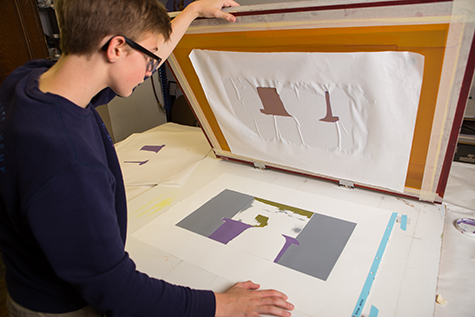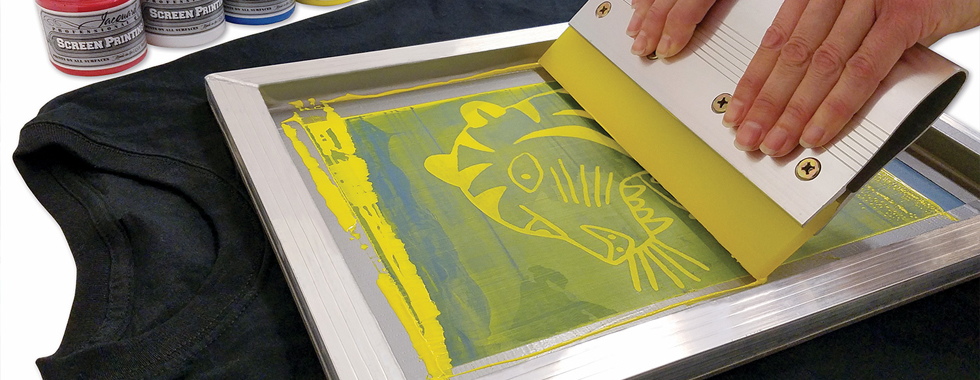ChatGPT said: 10:9 Design Abilene: local experts for custom apparel and branding
Discover the Numerous Sorts Of Screen Printing Techniques for Your Following Job
Screen printing uses a diverse array of techniques that can enhance any kind of creative job. From typical approaches like serigraphy to contemporary innovations such as direct-to-garment printing, each strategy has its distinct advantages. Specialized choices, including metal and eco-friendly inks, present a lot more opportunities. Comprehending these techniques can considerably affect the last outcome. Nevertheless, the challenge hinges on picking the most appropriate method for details requirements and preferred results. What elements should one think about?

The Basics of Screen Printing
Although screen printing might seem complicated, it is fundamentally a simple procedure that entails moving ink with a mesh screen onto various surfaces. The method starts with the development of a pattern, which defines the design to be printed. This stencil is affixed to a mesh screen, normally made of polyester or nylon. As soon as the stencil is in place, ink is used to the screen and pushed with the mesh utilizing a squeegee, resulting in the desired pattern being published on the underlying material.
Screen printing can be performed on a wide array of substrates, consisting of fabric, paper, and plastic, making it a functional option for different tasks. The process enables intricate layouts and vivid colors, making it popular in sectors such as marketing, art, and style. Understanding these basics gears up people with the fundamental expertise required to explore advanced techniques in screen printing.
Standard Screen Printing Techniques
Typical screen printing techniques have been used for centuries, preserving the craftsmanship and creativity of this method. This strategy makes use of a mesh screen to move ink onto a substrate, such as material or paper, permitting durable and vibrant styles. The procedure begins with creating a stencil, which obstructs particular locations of the screen to regulate where the ink will be used.
One prominent method is serigraphy, frequently made use of for imaginative prints and limited versions. An additional is making use of water-based inks, which are environmentally friendly and provide a soft feeling on textiles - 10:9 Design Screen Printing. Additionally, standard approaches can include hand-operated printing, where craftsmens apply ink with a squeegee, guaranteeing accuracy and interest to detail
These strategies stay valued in the market for their responsive top quality and the one-of-a-kind appearances they generate, attracting both customers and creators that value the heritage of screen printing.
Digital Screen Printing Innovations
As the demand for faster manufacturing and personalization in the printing market has actually risen, digital screen printing technologies have arised as a game-changer. This innovation blends traditional screen printing techniques with electronic procedures, enabling fast prototyping and elaborate styles that were previously hard to accomplish. One significant innovation is the introduction of direct-to-garment (DTG) printing, which assists in top notch, full-color prints on numerous fabrics without the need for displays. In addition, developments in ink formulations have actually caused environmentally friendly choices that keep vivid colors while minimizing environmental effect. Using automated systems even more improves manufacturing, decreasing labor costs and boosting accuracy. These advancements not only accommodate little set orders and individualized designs but likewise permit for quicker turn-around times, making them ideal for companies concentrated on conference consumer needs in a hectic market. Digital screen printing, as a result, represents a vital advancement in the domain name of printing strategies.
Specialty Screen Printing Methods
Checking out specialty screen printing approaches reveals a diverse array of strategies that push the borders of creativity and capability in the printing sector. Among these, glow-in-the-dark inks give a distinct visual impact, making designs come active in low-light problems. Metallic inks, understood for their shimmering coating, include a touch of luxury to published materials. Another ingenious method is discharge printing, which removes color from the fabric as opposed to adding ink, resulting in a soft, classic feeling. High-density printing creates a raised structure externally, improving tactile engagement. Furthermore, water-based inks are obtaining popularity for their vivid shades and reduced environmental influence. Each of these specialty strategies caters to certain layout needs, enabling musicians and brand names to produce standout products that reverberate with their audiences. By leveraging these methods, businesses can raise their screen printing jobs to brand-new heights, making sure remarkable perceptions.
Eco-Friendly Screen Printing Options
Green screen printing options are acquiring grip as the sector shifts in the direction of sustainability. Sustainable ink selections and making use of eco-friendly materials are crucial parts in decreasing the ecological impact of the printing procedure. By adopting these practices, screen printers can add to a much more lasting future while keeping high-grade outcomes.
Sustainable Ink Options

Biodegradable Materials Use
As the screen printing market evolves, the incorporation of biodegradable products is becoming increasingly crucial for eco mindful techniques. Designers and makers are now checking out inks and substrates made from all-natural, sustainable sources that break down more successfully than conventional equivalents. These naturally degradable choices lower plastic waste and decrease ecological influence, straightening with the growing demand for sustainable index products.
Common instances consist of water-based inks and natural cotton textiles, both of which reduce damaging chemicals and promote eco-friendliness. Brand names that embrace these products often improve their market appeal, drawing in consumers who prioritize sustainability. As recognition of environmental problems continues to increase, the shift in the direction of biodegradable products in screen printing is most likely to get momentum, fostering a greener market criterion.
Choosing the Right Technique for Your Project
How can one identify the most appropriate screen printing method for a details job? The choice pivots on numerous aspects, consisting of the product to be published on, the complexity of the layout, and the desired production quantity - 10:9 Design Embroidery. Direct-to-garment printing is perfect for elaborate designs with many colors, while standard screen printing stands out for larger runs of simpler graphics.
Furthermore, consideration of the end-use of the published item is important. For exterior applications, techniques that supply resilience and weather resistance, such as plastisol ink, may be chosen. Conversely, environmentally-conscious projects might gain from naturally degradable products or water-based inks.
Ultimately, recognizing the job's distinct needs permits an informed choice, guaranteeing both aesthetic allure and practical longevity. By reviewing design intricacy, material compatibility, and production scale, one can efficiently pick one of the most suitable screen printing technique to satisfy their task's objectives.
Often Asked Questions
What Is the History of Screen Printing?
Screen printing came from ancient China around 1000 AD, progressing with Japan and Europe. By the 20th century, it ended up being preferred in business art and fashion, revolutionizing exactly how styles were produced and dispersed globally.

Exactly how Do I Prepare Artwork for Screen Printing?
To prepare art work for screen printing, one have to assure high resolution, utilize an ideal shade setting, develop separate layers for each and every shade, and convert message to details, guaranteeing compatibility with the printing process and wanted end result.
What Products Are Finest for Screen Printing?
The most effective products for screen printing include premium inks, resilient screens, and suitable substratums like cotton, polyester, or blends. Furthermore, utilizing suitable emulsion and squeegees can boost the printing process and outcomes.
Can I Screen Publish in the house?
Yes, screen printing at home is feasible. With the best materials, setup, and strategies, individuals can produce high-grade prints. However, careful consideration of office and devices is important for effective outcomes.

What Are Typical Blunders in Screen Printing?
Common blunders in screen printing include incorrect direct exposure times, poor ink consistency, misalignment of displays, inadequate cleaning of products, and disregarding to examine prints. These errors can jeopardize the high quality and accuracy of the end product.
Screen printing may appear facility, it is fundamentally a simple process that involves transferring ink with a mesh screen onto various surface areas. As the need for faster manufacturing and customization in the printing sector has surged, digital screen printing technologies have arised as a game-changer. Discovering specialty screen printing techniques discloses a varied variety of methods that push the boundaries of imagination and capability in the printing industry. The finest products for screen printing include high-grade inks, resilient screens, and appropriate substrates like cotton, polyester, or blends (10:9 Design near me). Common errors in screen printing consist large signage of incorrect direct exposure times, insufficient ink consistency, imbalance of displays, not enough cleaning of materials, and disregarding to examine prints